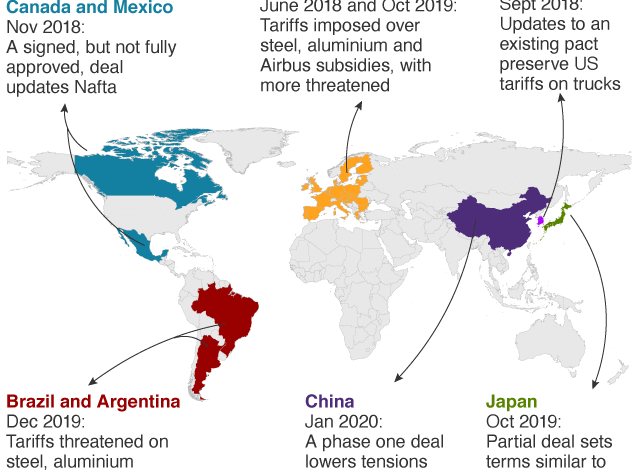Trump Tariffs on Brazil and Canada: 50% and 35% Levies

In a bold move, Trump tariffs on Brazil and Canada have recently reshaped the framework of international trade. President Donald Trump enacted a hefty 50% tariff on imports from Brazil, while a 35% tariff on Canadian goods marks a significant shift in U.S. trade policies, particularly impacting its second-largest trading partner. This action comes amid ongoing negotiations regarding the U.S.-Mexico trade deal, which Trump has indicated requires further time for resolution. Amid rising tensions, many are watching closely to see how these tariffs will influence the broader context of US tariffs news and trade relations in North America. As the political landscape evolves, these tariffs may be the tip of the iceberg in a series of strategic economic maneuvers by the Trump administration.
The recent imposition of levies by President Trump on trade with Brazil and Canada signals a critical juncture in U.S. economic relations. These punitive measures, instituted with a 50% tariff on Brazilian imports and a 35% tariff on Canadian products, underscore a pivotal shift in America’s approach to trade negotiations and policy enforcement. Amidst discussions of a complex North American trade agreement, these tariffs reflect a focused stance towards countries perceived as engaging in adversarial practices. Analysts suggest that these actions may not only impact immediate trade dynamics but could also establish a precedent for how the U.S. interacts with its neighbors and manages its international trade obligations. As these developments unfold, stakeholders across various sectors are bracing for potential repercussions in the market.
Trump Tariffs on Brazil: A 50% Trade Shock
President Donald Trump’s recent decision to impose a 50% tariff on imports from Brazil has sent ripples through global trade markets. This dramatic increase in tariffs was justified by the Trump Administration by citing threats to national security and foreign policy, specifically referencing Brazilian government actions that allegedly endangered U.S. interests. The implications of such punitive measures will likely affect not only trade balances but also diplomatic relations between the two nations, prompting analysts to speculate about potential retaliatory measures from Brazil in the future.
For U.S. consumers, this steep tariff may mean higher prices on imported goods from Brazil, such as coffee and industrial products. The decision to exclude certain categories like civil aircraft and precious metals from these tariffs indicates a strategic approach to minimizing disruptions while still exerting pressure on Brazil. Furthermore, the immediate economic consequences will likely reverberate through supply chains, affecting American businesses reliant on Brazilian imports, and could further complicate the trade landscape in the region.
Canada Faces 35% Tariffs and Trade Tensions
In a parallel move, President Trump has announced a 35% tariff on Canadian goods, heightening tensions with one of America’s most significant trading partners. The primary reason cited for this sharp increase is Canada’s alleged failure to curb the influx of fentanyl and other drugs into the United States. By taking a hardline stance, Trump aims to exert pressure on Canada to cooperate more fully in addressing issues that pose substantial risks to American public health and safety.
The imposition of these tariffs could have wide-reaching consequences for Canadian industries, especially those in the agricultural and manufacturing sectors, which are highly dependent on exports to the U.S. Consequently, businesses are beginning to prepare for potential disruptions in trade flows, while the Canadian government may seek alternative markets to mitigate risks. Observers are closely monitoring the potential for retaliation from Canada as both nations navigate this increasingly complex trade relationship.
Additionally, the tariff’s linkage to Canada’s political decisions, such as recognizing Palestine, hints at the broader implications of Trump’s trade policies, which extend beyond economics into the realm of diplomatic strategy.
Impact of Trump Trade Policies on North American Trade Relations
The recent tariffs imposed by Trump on Brazil and Canada highlight a pivotal shift in U.S. trade policy, reflecting a more confrontational approach. Trump’s decision to push for significant tariffs showcases a strategy grounded in national security concerns, leveraging economic tools to address perceived threats from foreign governments. This dramatic pivot could reshape North American trade relations, especially as Mexico has been granted a temporary reprieve, complicating the tri-nation trade dynamics under existing agreements.
As trade negotiations progress, the prospects for a comprehensive deal are clouded with uncertainty. The diverse reactions among affected nations will fuel ongoing discussions about how tariffs can impact socioeconomic stability across North America. Analysts indicate that understanding these developments is crucial for businesses and policymakers alike, as they navigate a landscape that’s rapidly evolving due to aggressive trade strategies initiated by the U.S.
Mexico’s Extended Negotiation Phase Amid Rising Tariffs
In the shadow of rising tariffs on Brazil and Canada, Mexico has received an extension from President Trump to continue negotiating a better trade agreement. This 90-day delay reflects the complexities surrounding the U.S.-Mexico trade relationship, wherein tariffs of 25% and 50% on certain goods remain in place. Trump’s remarks about knowing and understanding Mexican President Claudia Sheinbaum suggest a willingness to strengthen bilateral ties, albeit through stringent economic measures.
This extension can be seen as an opportunity for Mexico to secure more favorable terms in its trade dealings with the U.S., particularly as the threat of escalating tariffs looms large. Both countries are now at a crossroads where effective negotiation strategies could lead to more stable trade relations moving forward, especially in critical sectors such as steel, aluminum, and agricultural exports.
Understanding the Economic Implications of Trump’s Tariffs
The economic implications of Trump’s tariffs on Brazil and Canada are far-reaching, affecting not just international trade but also domestic markets and consumer prices. With a 50% and 35% tariff respectively, American consumers may soon feel the pressure of increased costs on goods previously imported from these countries. This shift underscores the importance of examining how such trade policies could lead to inflationary pressures within the U.S. economy, especially in light of already rising prices in other sectors.
For manufacturers and businesses, the response to these tariffs may require strategic shifts, including turning to alternative suppliers or investing in domestic production capabilities. Firms may be forced to re-evaluate their global supply chains in order to mitigate the adverse effects of increased tariffs, making it crucial for businesses to stay informed on U.S. tariffs news and adapt proactively to the rapidly changing trade environment.
Potential Retaliation Strategies from Brazil and Canada
As the U.S. imposes significant tariffs on Brazilian and Canadian imports, the potential for retaliation from these countries becomes increasingly likely. Brazil, aggrieved by the 50% tariff, may seek to target key U.S. exports or impose their own restrictions on imports, creating a tit-for-tat scenario that could further destabilize regional trade. Canadian officials have already hinted at leveraging their trading relationships with nations around the globe, exploring new partnerships while maneuvering within the established U.S.-Canada trade framework.
Such retaliatory measures emphasize the interconnected nature of global trade and the reciprocal impacts of tariff-based decisions. Understanding these dynamics is critical for both consumers and businesses as they prepare for potential shifts in trade policies that could alter market conditions significantly. Analysts are already speculating on how retaliatory tariffs could affect various sectors, particularly agriculture and technology, that are heavily reliant on trade agreements.
Analyzing the Long-Term Effects of Trump’s Trade Policies
The long-term effects of Trump’s trade policies, particularly regarding tariffs on Brazil and Canada, warrant careful examination as they could reshape the landscape of international trade. As countries react and adapt to these measures, shifts in import-export balances will likely become evident in the coming months and years. This could lead to emergent trade alliances or more regional trade agreements aimed at countering U.S. tariffs.
Additionally, economists will be observing how these policies impact the global economy. The potential for increased isolation of the U.S. in international trade discussions could have substantial implications, particularly if key trading partners seek avenues to bypass tariffs. Monitoring the unfolding scenario will be essential for all stakeholders concerned about navigating the ever-evolving complexities of trade policy.
The Role of Trade Agreements in Mitigating Tariff Impacts
In light of the recent tariffs imposed by Trump, trade agreements emerge as a pivotal tool for nations to negotiate terms that mitigate the adverse effects of such levies. Existing frameworks can provide a foundation for renegotiation, helping countries like Mexico find common ground while diverse trading partners react to U.S. policies. As nations work towards more robust agreements, the need for collaborative efforts to address shared challenges of illegal drugs and tariffs will remain essential.
Moreover, nations will need to prioritize the modernization of trade agreements that encompass emerging trade challenges, ensuring they remain adaptable in the face of unforeseen tariff actions. The agility of these agreements will play a crucial role in fostering economic stability and resilience against the backdrop of ongoing U.S. trade negotiations.
Future of Trade Relations in the Era of Tariffs
Looking ahead, the future of trade relations will be inexorably shaped by the tariffs imposed on countries like Brazil and Canada. The Trump Administration’s approach emphasizes a transactional nature to trade, which could linger beyond his presidency. Such a framework may give rise to increased protectionism as a default response to trade disputes, transforming the way nations interact economically.
As global markets react, ongoing adjustments in trade policy will be crucial for maintaining positive relationships. Developing strategies to manage tariff impacts, along with fostering dialogue around pressing trade issues, will be essential as countries collectively seek to adapt to the new realities of international trade put forth by recent U.S. policies.
Frequently Asked Questions
What are the Trump tariffs on Brazil and Canada in 2023?
In 2023, President Trump imposed tariffs of 50% on imports from Brazil and 35% on imports from Canada. These tariffs were enacted in response to actions by the Brazilian government that were perceived as threats to U.S. national security and foreign policy.
How do Trump tariffs on Brazil affect U.S. trade relations?
The 50% tariffs on Brazil significantly impact U.S. trade relations by increasing the cost of Brazilian imports, thereby aiming to balance trade deficits and address concerns over censorship and data sharing by Brazilian institutions.
What goods are exempt from the Trump tariffs on Brazil?
Certain goods, including civil aircraft, precious metals, energy imports, and fertilizers, are exempt from the 50% tariffs on Brazil. However, notable products like coffee are not exempt.
Why did Trump impose a 35% tariff on Canada?
The 35% tariff on Canada was imposed due to concerns over Canada’s handling of illegal drugs, particularly fentanyl, and its retaliatory actions against the U.S. The tariff is part of Trump’s broader trade policies aimed at addressing national security issues.
What does the ‘Mexico trade deal’ mean in the context of Trump’s tariffs?
The ‘Mexico trade deal’ refers to negotiations surrounding tariffs on Mexican imports, which currently incur a 25% tariff, alongside a 50% tariff on key metals. Trump granted Mexico a 90-day extension for negotiations, suggesting a different approach compared to negotiations with Brazil and Canada.
How are Trump’s trade policies influencing U.S. relations with Brazil and Canada?
Trump’s trade policies, including the recent tariffs, are straining U.S. relations with Brazil and Canada by raising trade costs and introducing tension over issues such as drug trafficking and international diplomacy.
What impact do the Trump tariffs have on consumers in the U.S.?
The Trump tariffs on Brazil and Canada may lead to higher prices for imported goods, as tariffs are typically passed down to consumers. This could affect a variety of products, particularly those not exempted from the tariffs.
What is the latest US tariffs news regarding Brazil and Canada?
As of the latest updates, President Trump has officially imposed a 50% tariff on Brazil and a 35% tariff on Canada, citing national security concerns and retaliatory actions as the justification for these measures.
Are there exceptions to the tariffs imposed on Canada under Trump’s policies?
Currently, there are no specific exceptions noted for the 35% tariffs imposed on Canada; however, the U.S. government may negotiate future exemptions as trade talks progress.
| Key Point | Description |
|---|---|
| Tariffs Imposed on Brazil | President Trump has levied a 50% tariff on imports from Brazil. |
| Tariffs Imposed on Canada | A 35% tariff on Canadian imports was implemented. |
| Rationale for Tariffs | These tariffs were described as efforts to address threats to U.S. national security and foreign policy. |
| Exempt Products | Certain products like civil aircraft and energy imports are exempt from tariffs, except for coffee. |
| Time Extension for Mexico | Mexico received a 90-day extension to negotiate better trade terms with the U.S. |
| Drug-related Concerns | The tariff on Canada was partly justified by an increase in illegal drug influx and retaliatory actions. |
Summary
Trump tariffs on Brazil and Canada have been officially imposed, marking a significant shift in U.S. trade policy. With a 50% tariff on Brazil and a 35% tariff on Canada, these actions are seen as responses to perceived threats to national security and other political issues. Additionally, the decision to provide Mexico with an extension indicates nuanced trade negotiations tailored to regional complexities. This development highlights the ongoing challenges and strategic decisions facing the U.S. in its international trade relationships.




